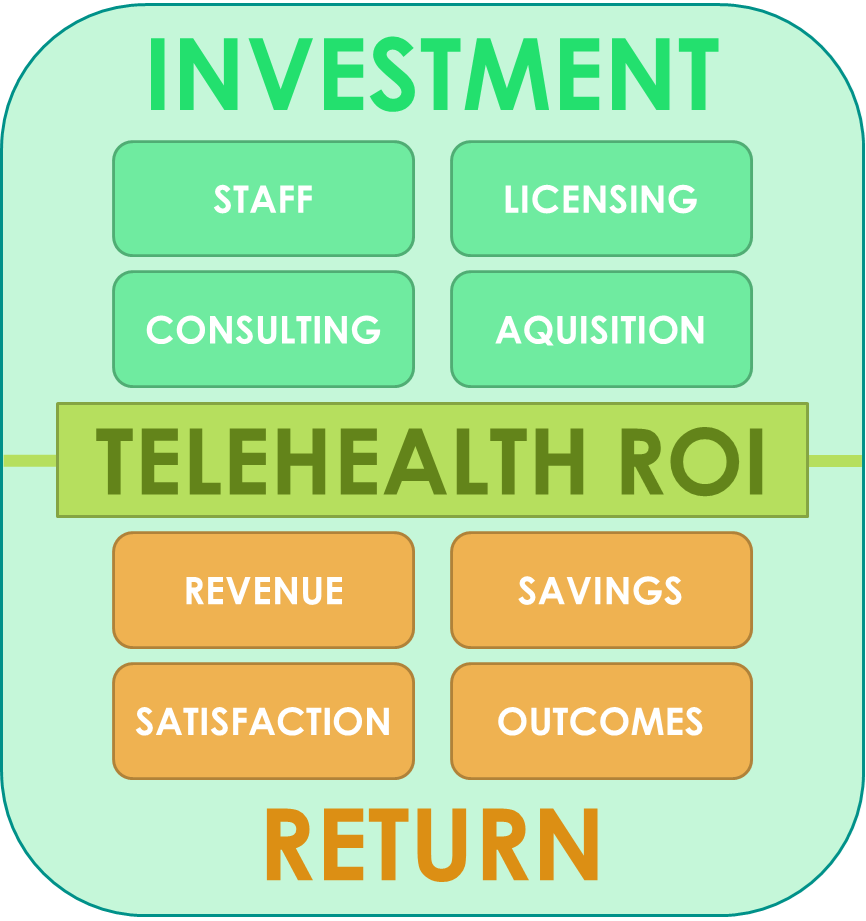As healthcare organizations are realizing that telehealth is here to stay, the attention quickly turns to three important questions: what should our telehealth services roadmap look like, what is the right technology we should be using and how can we make telehealth financially sustainable?
In this week’s article, I’ll provide some ideas on the last question: how to maximize the ROI of Telehealth.
Elements of Telehealth ROI
ROI, or return on investment, is a simplified calculation that, generally speaking, calculates the value of an investment: If for every 10 dollar invested you generate 25 dollars worth of return, your return on that 10 dollar investment is 15 dollars, or 150%.
A positive ROI is obviously important to sustain the service, otherwise it needs to be subsidized. Across any given health systems a number of health services are “money losers” that need to be subsidized by those services with a high return on investment.
When we work with our clients we aim to develop a program-level telehealth accounting system that looks at the cost and the benefits (“value generated”) of all telehealth services. The idea behind that approach is to ensure the overall sustainability of the telehealth program by ensuring that those services that may provide a negative ROI are offset by those that provide a positive ROI.
For example, some readmission RPM programs return $130 dollars for every $10 invested, an ROI of 13:1 or 1,300%! (I’d like to have that kind interest on my savings account 😉 Other services, due to issues with collections on copays or lower reimbursement, may have negative ROIs of -20%, i.e., a loss of $2 on every $10 invested.
Qualitative and Quantitative Value
The value in an ROI calculation can be measured both quantitatively and qualitatively.
Qualitative value measures intangible things such as patient or physician satisfaction or the net promoter score (NPS) that measures patients willingness to recommend, to promote the service to others. While they can be measured, they are qualitative in the sense that they cannot easily and reliably be converted into dollar amounts.
The most obvious quantitative value measure is the reimbursement or cash pay for the rendered telehealth service. Other quantitative measures that we’ll discuss in more detail below, include other means of generating revenue as well as increasing savings or securing grants.
The Cost of Telehealth
To calculate the ROI, you first need to comprehensively account for all the costs associated with providing the service. This includes the salary of the clinicians as well as the clinical and administrative support staff; and ongoing technology licensing fees as well as the depreciation of one-time investments, such as hardware or software acquisition and installation cost.
A note on the licensing cost: these days most telehealth solutions are very reasonably priced and don’t offer much differentiation to boost the ROI of a telehealth service. Given the typical volume of telehealth visits per month — even if only practiced part time — the per-visit fees of the technology can be as low as $0.50.
The highest cost of any telehealth services is thus by far the cost of the clinicians, though the cost of support staff (especially in services whose workflows are not optimized or when highly cumbersome or non-intuitive technology is used) can also contribute significantly to this side of the ROI equation.



Telehealth Value with an Impact on the Bottom-Line
When looking at the quantifiable value of telehealth there are two areas of value that have an impact on the bottom line: increasing revenue and increasing savings.
Aside from the obvious reimbursement, which is listed below for a complete list, there are however a number of other ways to increase revenue with a telehealth service:
- Fee-for-service reimbursement
- Increase in utilization through increased convenience
- Meeting demand through high capacity
- Geographic Expansion leading to increase in utilization
- Expansion of service offerings (e.g., new specialities)
- Drastic (80%) reduction of no shows (from 20% to 4%)
- Referrals and downstream service utilization.
- Eligibility for grant programs
- Co-Pay Collection Optimization
On the other side, here are the number of ways to increase savings through telehealth:
- Readmission prevention: non-reimbursed hospitalization cost and potential penalties
- Reducing high-cost utilization in ACO/Shared Savings arrangements
- Skilled Nursing Facility spending & readmissions (MSPB)
- Load-balancing to increase utilization of existing capacity
- Value-based care programs
- Quality-score based incentive programs
- State-specific potentially avoidable utilization penalties
- Other penalties or payment reductions.
Maximizing your Telehealth ROI
As illustrated by these two lists, there are a number of ways how telehealth can be leveraged as a strategic tool to drive the increase in revenue or the increase in savings, based on the circumstances and strategic priorities of the organization.
As laid out in the cost section, lower technology-related expenses usually is not the most lucrative way to increase the ROI, unless of course you are subscribing to an expense service that provides the clinicians in addition to the technology. Here, the solution may be to bring the services in house.
The three most powerful tactics to maximizing Telehealth ROI are:
- Roll up the ROI of all telehealth services at the telehealth program level to manage all virtual care offerings together to achieve synergies.
- Focus on building and growing those services with a high potential for a high ROI, rather than “making it up in volume” for telehealth services that are losing money each visit
- Intentionally select new telehealth service offerings that can be designed for maximum ROI, thus using telehealth as a strategic tool, for example, to eliminate penalties, reduce no shows, etc.
How are you measuring the ROI of your telehealth service offerings? When launching a new service, do you set expectations for an ROI? Let me know!








To receive articles like these in your Inbox every week, you can subscribe to Christian’s Telehealth Tuesday Newsletter.
Christian Milaster and his team optimize Telehealth Services for health systems and physician practices. Christian is the Founder and President of Ingenium Digital Health Advisors where he and his expert consortium partner with healthcare leaders to enable the delivery of extraordinary care.
Contact Christian by phone or text at 657-464-3648, via email, or video chat.







Leave A Comment